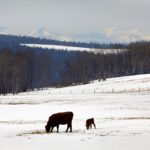
Cow-Calf

Other indicators affecting cattle market decisions
Risk Management Part 4: Who’s using the futures market and what are their intentions?

Supplying good cow nutrition in the post-calving season
Ramp up ration as cow gets closer to calving — and beyond

Tips on getting a newborn calf breathing
Hanging them upside down doesn’t work and can make things worse

Spring is welcome, but it brings its own issues for calves
Pen Checker Diary: Nicer weather comes with a whole parcel of animal health risks

Problems and benefits of twin calves
Animal Health: It is worth the extra management effort to save both calves
Feeder cattle basis analysis
Finishing at least some of your own calves is a diversification measure

Proper diets take a bite out of wind chill
When temperatures dip, it’s time to torque up the ration

Dealing with contracted or lax leg tendons in calves
Animal Health: In many cases, time and a bit of physiotherapy will fix the condition

Flight zones can teach some lessons
Cattle behaviour may not be all that much different than how humans handle life

Important tips for pulling a calf
Have chains properly positioned; be gentle with the calf puller


